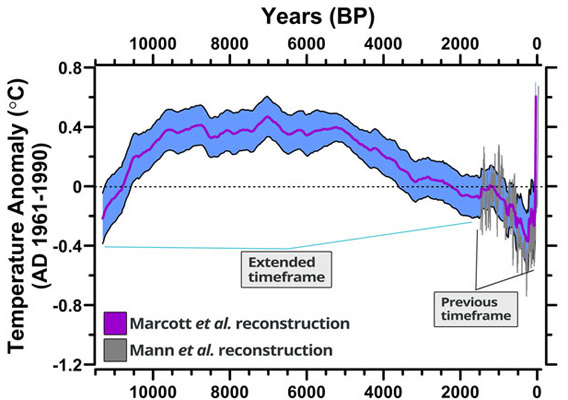The Hockey Stick Hasn’t Changed
The latest major climate study was released earlier this month. It is the largest and most important study since the BEST (Berkeley Earth Surface Temperature) study published in 2011. This one reached back 11,300 years to reconstruct temperature and climate data.
In paleoclimatology there are a number of ways we can reconstitute past climates. Ice cores are the token example, but scientists can also study ancient climates using tree rings, ocean sediments, samples of buried pollen and fossils of once-living organisms.
This study used fossilized ocean shells as proxy data, which provided temperature data right up to the early Holocene epoch. For 70-80% of this period, the planet was cooler, globally, than today. Holocene temperatures exceeded climate temperatures at its interglacial apogee and then settled into a cooling phase. The difference between the early and mid-Holocene oscillations and today’s trend is the rate of change. While past fluctuations were more relaxed in nature, the current pattern is acute and inconsistent with known drivers. There is simply no precedent for the spike in global temperatures we’ve seen since the 1800s.
The data compiled by this latest study further corroborate our existing data and expands our corpus of historical data. The hockey stick has only been extended to account for deeper data. The conclusion is the same: the rate of change accelerated contemporaneously with the uptick in fossil fuel production circa the Industrial Revolution, just as research in the 19th century presciently demonstrated. Our current trend cannot be adequately captured by past linkages and is presently unexplainable apart from anthropogenic GHG emission.
The most disturbing excerpt from the report is the following:
“Intergovernmental Panel on Climate Change model projections for 2100 exceed the full distribution of Holocene temperature under all plausible greenhouse gas emission scenarios.”
If we falter on curbing emissions, there is no reason to think temperatures won’t continue down their current trajectory. Soon we will be speeding past even maximum Holocene temperatures and reaping the burdens those changes will bring.
External link: The Earth Is Warming Faster Now Than It Has in 11,000 Years
Feature image courtesy of theatlanticwire.com




Comments